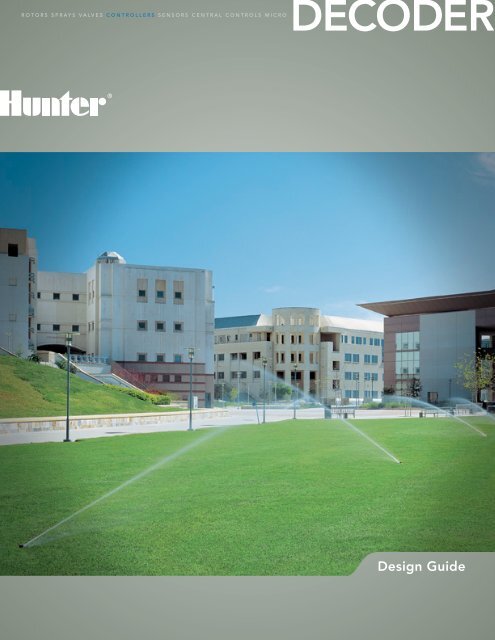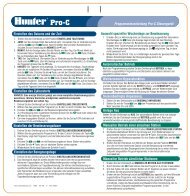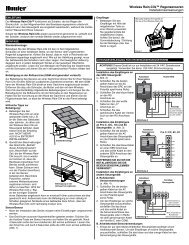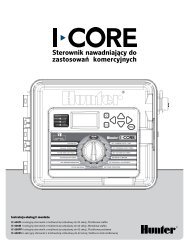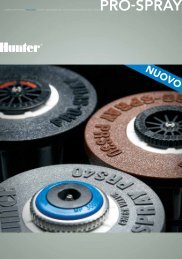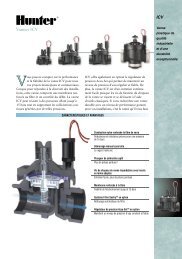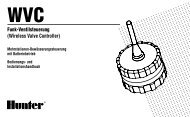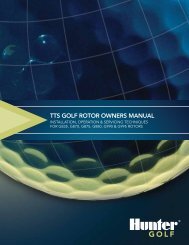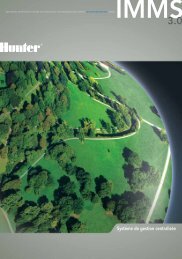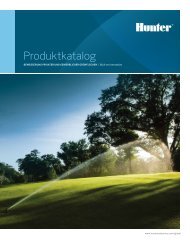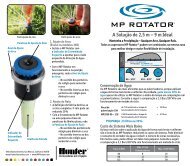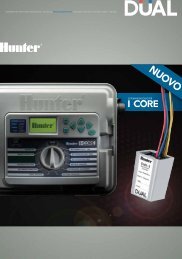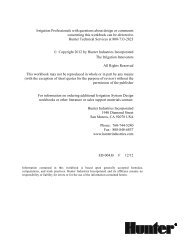Decoder Design Guide - Hunter Industries
Decoder Design Guide - Hunter Industries
Decoder Design Guide - Hunter Industries
You also want an ePaper? Increase the reach of your titles
YUMPU automatically turns print PDFs into web optimized ePapers that Google loves.
ROTORS SPRAYS VALVES CONTROLLERS SENSORS CENTRAL CONTROLS MICRO<strong>Decoder</strong><br />
<strong>Design</strong> <strong>Guide</strong><br />
WEB-103 6/08
<strong>Decoder</strong> Systems<br />
Overview of <strong>Decoder</strong> Operation............................................................................................................ 3<br />
<strong>Decoder</strong> Benefits.................................................................................................................................... 3<br />
Wire Specifications & Rules.................................................................................................................... 4<br />
Wire Connectors................................................................................................................................................. 5<br />
"T" Splicing <strong>Decoder</strong> Wire..................................................................................................................... 5<br />
Earth Grounding..................................................................................................................................... 6<br />
<strong>Decoder</strong>-to-Solenoid Wiring................................................................................................................... 6<br />
<strong>Decoder</strong> Outputs, Power Factors, and Inrush......................................................................................... 7<br />
<strong>Decoder</strong> Hardware & Models................................................................................................................. 7<br />
ICD <strong>Decoder</strong> Models......................................................................................................................................... 7<br />
Programming <strong>Decoder</strong>s..................................................................................................................................... 8<br />
ICD-HP Handheld Programmer......................................................................................................................... 9<br />
Pump Starts......................................................................................................................................................... 9<br />
ICD-SEN (ACC systems only)............................................................................................................................ 9<br />
Wireless Remote Controls (ICR, ROAM, Maintenance Radio)...................................................................... 10<br />
Central Compatibility....................................................................................................................................... 10<br />
ACC <strong>Decoder</strong> Installation Specifications............................................................................................... 10<br />
General.............................................................................................................................................................. 10<br />
Cable.................................................................................................................................................................. 11<br />
Layout................................................................................................................................................................ 11<br />
Cable <strong>Design</strong> Formulas......................................................................................................................... 12<br />
Wire Path Length Formula............................................................................................................................... 12<br />
Examples........................................................................................................................................................... 13<br />
Conditions......................................................................................................................................................... 13<br />
<strong>Design</strong> Suggestions......................................................................................................................................... 13<br />
Cables from <strong>Decoder</strong> to Solenoid(s)..................................................................................................... 14<br />
Multiple Solenoids from One <strong>Decoder</strong> Output.................................................................................... 14<br />
Power Factor........................................................................................................................................ 14<br />
Surge Protection.................................................................................................................................. 14<br />
Earth Grounding <strong>Hunter</strong> <strong>Decoder</strong> Systems........................................................................................... 15<br />
Controllers......................................................................................................................................................... 15<br />
<strong>Decoder</strong> Grounding......................................................................................................................................... 16<br />
<strong>Decoder</strong> Grounding.............................................................................................................................. 17<br />
<strong>Decoder</strong> In-Valve Box........................................................................................................................... 17<br />
<strong>Decoder</strong> Systems <strong>Design</strong> <strong>Guide</strong> • Page 2 • www.hunterindustries.com
ACC99D with Two-wire path (up to 99 stations)<br />
DESIGN GUIDE<br />
The ACC Controller family is available in two-wire decoder configurations. It is also possible to<br />
convert a conventional ACC family controller to two-wire decoder operation, by removing the<br />
conventional output modules and inserting the ADM-99 <strong>Decoder</strong> Output Module.<br />
For purposes of this document, "conventional" or "conventionally-wired" means control systems<br />
having a separate wire terminal for each station output, running from the controller to each<br />
system solenoid, as opposed to two-wire decoder control.<br />
The DUAL Difference<br />
The "DUAL" family of decoder products for the I-Core controller were added to the <strong>Hunter</strong> line<br />
in January, 2010. DUAL decoders share many characteristics of the ACC/ICD family, but there are<br />
some important differences. Look for "The DUAL Difference" sidebars in this document. They will<br />
call attention to important DUAL differences from ICD decoders.<br />
ACC99D with<br />
Two-Wire path<br />
(up to 99 stations)<br />
Overview of <strong>Decoder</strong> Operation<br />
<strong>Decoder</strong> in valve box<br />
Two-wire decoder technology permits control of large irrigation systems, over<br />
relatively long distances, by inserting waterproof decoder modules as needed in a<br />
low voltage, direct burial two-wire path.<br />
The wire is cut wherever station control is needed, and the decoder wires<br />
are spliced into the path. The decoders are then connected to local<br />
standard 24 VAC solenoids for individual operation of valves and<br />
similar devices.<br />
<strong>Decoder</strong> in Valve Box<br />
Each decoder is uniquely addressed, and both the signal for their address, and the power<br />
required for solenoid operation, are sent over the single pair of wires. Up to 99 decoders can be<br />
individually operated over a single pair of wires in this manner.<br />
<strong>Decoder</strong> Benefits<br />
• <strong>Decoder</strong> systems save wire. The greatest attraction to many users is the ability to operate 99 stations with only two wires<br />
(usually 14 AWG/2.08 mm 2 solid copper), instead of 100+ wires. They can also save connectors and labor associated with<br />
large numbers of individual wire runs.<br />
The DUAL Difference<br />
DUAL systems operate up to 48 decoders. DUAL uses the same wire, but the<br />
distances are not quite as great:<br />
• 14 AWG/2.08 mm 2 = 5,000 ft/1,500 m, max<br />
• 12 AWG/3.3 mm 2 = 7,500 ft/2,300 m, max<br />
• DUAL provides 3 two-wire paths to the field<br />
Two-wire path (IDWIRE)<br />
• <strong>Decoder</strong> systems are flexible. As long as the two-wire path is reasonably<br />
accessible throughout an irrigation system, stations can be added later<br />
by inserting additional decoders into the path at any point, with minimum<br />
disruption of turf and landscape. <strong>Decoder</strong> wire runs can even be spliced<br />
and tee’d to follow pipe trenches and minimize wasted wire.<br />
Typical Field <strong>Decoder</strong> Wiring<br />
• <strong>Decoder</strong> systems are electrically efficient. They have the ability to operate<br />
large numbers of solenoids over relatively long distances.<br />
»»<br />
With 14 AWG/2.08 mm 2 solid wire, a controller can activate solenoids up to 10,000 ft/3 km away (metric diameter based<br />
on commonly available wire sizes in international markets. IDWIRE1 is technically 1.63 mm diameter, or 2.08 mm 2 area).<br />
»»<br />
With 12 AWG/3.3 mm 2 dia. wire, they can operate up to 15,000 ft/4.5 km. Longer runs are possible with even heavier wire,<br />
but not practical.<br />
<strong>Decoder</strong> Systems <strong>Design</strong> <strong>Guide</strong> • Page 3 • www.hunterindustries.com
<strong>Decoder</strong> Systems<br />
»»<br />
The ACC family of decoder controllers provides up to 6 two-wire paths to the field. Therefore, a controller can operate up<br />
to 15,000 ft/4.5 km in each of 6 different directions.<br />
• <strong>Decoder</strong> systems are lightning resistant. While no irrigation system is immune to lightning, decoder systems have less wire in<br />
the ground and, when properly installed, have excellent grounding and surge suppression. They are popular in regions with<br />
high lightning exposure.<br />
• <strong>Decoder</strong> systems are relatively easy to troubleshoot. There are only two wires per path, and a single output module for the<br />
decoder functions, equipped with diagnostic LEDs. The controller operating system is the same as a conventional ACC, and<br />
for customers who are already familiar with ACC operations there is little new to master in decoder programming.<br />
Wire Specifications & Rules<br />
Wire, and wire installation, is a key factor in successful decoder installations. Substitution of wire and wire splices is at the<br />
installer’s own risk and is the major cause of start-up service troubles.<br />
<strong>Hunter</strong> provides various wire models for use with ACC decoder systems. <strong>Hunter</strong> recommends the color-coded wire selections<br />
with outer jacket for additional protection of decoder wire.<br />
Model Description Specifications<br />
ID1GRY<br />
Gray outer jacket<br />
ID1PUR<br />
ID1YLW<br />
ID1ORG<br />
ID1BLU<br />
Purple outer jacket<br />
Yellow outer jacket<br />
Orange outer jacket<br />
Blue outer jacket<br />
14 AWG/2.08 mm 2 solid-core<br />
twisted pair, 2,500 ft/760 m per<br />
standard spool<br />
(Use up to 10,000 ft/ 3 km)<br />
See The DUAL Difference box on<br />
page 3 for DUAL wire maximums.<br />
ID1TAN<br />
Tan outer jacket<br />
ID2GRY<br />
Gray outer jacket<br />
ID2PUR<br />
ID2YLW<br />
ID2ORG<br />
ID2BLU<br />
Purple outer jacket<br />
Yellow outer jacket<br />
Orange outer jacket<br />
Blue outer jacket<br />
12 AWG/3.32 mm 2 solid-core<br />
twisted pair, 2,500 ft/760 m per<br />
standard spool<br />
(Use up to 15,000 ft/4.5 km)<br />
ID1TAN, Showing Twisted Pair<br />
ID2TAN<br />
Tan outer jacket<br />
The twisted pairs are not shielded or armored, but the outer jacket provides protection from abrasion and sunlight damage.<br />
Conduit is not necessary unless local regulations require it (the two-wire path is low voltage). Shielding, steel armor, and conduit<br />
will not inhibit performance and are permissible when desired.<br />
• Paths: Each two-wire output run of wire is called a "path". The ACC99D provides up to 6 path outputs to the field, and the<br />
decoders may be installed on any or all of them in any combination. Color-coded external jackets allow each path to be<br />
identified in the field.<br />
• It is not necessary to connect the paths to one another. Each path runs from the controller to the last decoder in the path,<br />
and simply stops there. Generally, looping a two-wire path from one output to another (back to the controller) is not<br />
recommended. It provides little benefit and complicates troubleshooting.<br />
• Never connect a wire path from one controller to the wire paths from another controller<br />
<strong>Hunter</strong> requires twisted wire meeting the above specification on all paths. The twist in the wire is an essential part of the<br />
surge suppression scheme and works very well. The twist in the wire minimizes the difference in potential during a surge, and<br />
adds inductance. Since lightning damage is never covered by warranty, it is in the installer’s best interest to share what <strong>Hunter</strong><br />
has learned in nearly two decades of decoder installations, by using twisted wire that meets all the above specifications.<br />
Color coding is mandatory. The red/blue coding is a convenience for matching the wires to <strong>Hunter</strong> decoders. External colorcoded<br />
jackets aids in diagnostics after initial installation and protects wires from shorts to earth.<br />
<strong>Decoder</strong> Systems <strong>Design</strong> <strong>Guide</strong> • Page 4 • www.hunterindustries.com
DESIGN GUIDE<br />
Using pre-existing wire: This is strongly discouraged by <strong>Hunter</strong> for the following reasons:<br />
• It is unlikely that the pre-existing wire meets the specifications for gauge, twist, and solid copper<br />
• Pre-existing wire will not be color-coded correctly for the decoder wires<br />
• Pre-existing wire may have invisible problems (shorts, breaks, increased resistance, or damaged insulation) that will be<br />
inherited by the new installation<br />
It is unwise to take chances on large projects by trying to "beat" wire specifications.<br />
Wire Connectors<br />
All connections and splices in the red/blue two-wire path (IDWIRE) must be made with<br />
DBRY-6 or equal waterproof connectors.<br />
• All <strong>Hunter</strong> decoders are now supplied with DBRY-6 connectors<br />
• All "-6" connectors are rated to 600V direct burial and have high temperature<br />
resistance<br />
• Additional splices and connections in the two-wire path must be made with<br />
equivalent connectors<br />
Whenever a splice or connection is made, it is important to leave adequate slack in<br />
the wires. Leave 5 ft/1.5 m slack to prevent contraction of the wire from damaging the<br />
connections, and to allow the splices to be removed from the valve box for service<br />
or inspection.<br />
Wire slack may be coiled neatly or around the inside of the valve box.<br />
<strong>Decoder</strong>-to-Solenoid connections may be made with standard DBY or equal waterproof<br />
connectors. These require only 30V or similar ratings but still require slack and strain relief.<br />
Waterproof Connectors<br />
"T" Splicing <strong>Decoder</strong> Wire<br />
Wire slack for service<br />
• It is permissible to T-splice decoder wire paths<br />
• All T-splices must be made in valve boxes with DBRY-6 or equal connectors<br />
• T-splices consist of making a three way connection in the red wire, and a three way<br />
connection in the blue wire<br />
• It is especially important to allow adequate slack in a three-way splice. Each splice<br />
should be able to be withdrawn from the valve box for above-ground inspection<br />
and service.<br />
Where possible, it is desirable to run the two-wire paths in the same trenches as<br />
irrigation pipe. The pipe will provide some protection to the wire, and logically leads<br />
to the valves where decoders will be positioned (see illustration).<br />
The maximum run of a given wire type is valid from the controller to the end of each arm<br />
of the T.<br />
If the total distance from the controller to the end of each arm of the T is under 10,000 ft/3<br />
km (using ID1 wires as an example), the system meets specification, even if the total amount<br />
of wire exceeds 10,000 ft/3 km.<br />
Wire Slack for Service<br />
For example (using the more common 14 AWG/2.5 mm 2 ID1 wires), if a T is placed 5,000 ft/1.5 km from the controller, and 2 arms<br />
in different directions each run an additional 5,000 ft/1.5 km, the wire is within specifications. It is only 10,000 ft/3 km to the end<br />
of each arm of the T from the controller, even though there is 15,000 ft/4.5 km total wire connected to the output.<br />
It is possible to have more than one splice in a wire run, provided all the above conditions are met. With DUAL systems, the<br />
distances differ but the same principles apply.<br />
<strong>Decoder</strong> Systems <strong>Design</strong> <strong>Guide</strong> • Page 5 • www.hunterindustries.com
<strong>Decoder</strong> Systems<br />
In very large systems, the length of the wire run and the number of intervening devices (other decoders) may affect the ability<br />
to run simultaneous stations near the end of the wire run. This will not damage the equipment but may require adjusting station<br />
timing to prevent underpowering the solenoid outputs. The calculations near the end of this document help determine if there<br />
is adequate power for any given wiring scenario.<br />
Earth Grounding<br />
Earth Grounding of decoder systems is another part of installation that requires planning and careful installation. Properly<br />
grounded decoder systems perform very well even in regions with frequent lightning storms. Poor grounding often results in<br />
unnecessary equipment losses and irrigation down time.<br />
<strong>Decoder</strong> Grounding<br />
Earth grounding rules for the ACC99D family decoder controllers are the same as for<br />
other ACC controllers. A large ground lug, or clamp, is provided for connection<br />
of bare copper wire to earth grounding hardware.<br />
Ground level<br />
• Install the grounding wire and earth ground hardware at right<br />
angles from the two-wire paths, when possible<br />
<strong>Decoder</strong> installations also require earth grounding in the two-wire<br />
path itself, to protect the decoder investment. The ICD family of decoders features<br />
integrated surge suppression and each decoder module is equipped with a bare copper<br />
wire for connection to earth ground hardware.<br />
Earth ground should be connected at every 12th decoder, or 1,000 ft/330 m of wire run, whichever<br />
is shorter. The station size of the decoders is not taken into account for grounding purposes… every<br />
12th decoder module is the rule.<br />
Solid bare copper<br />
Shielding Wire<br />
Place Ground Plate<br />
in 6” wide trench,<br />
perpendicular to<br />
the yellow Shielding<br />
Wire, 8 feet<br />
away, 36” below<br />
ground level.<br />
The final decoder in any wire run should be grounded. This includes the final decoders in each of the different<br />
arms of a "T", if the arm is more than 500 ft/150 m.<br />
The DUAL Difference<br />
DUAL decoders do not include integrated surge suppression. Instead, install the DUAL-S surge arrestors after every 12th decoder,<br />
or 1,000 ft/300 m, at a minimum. In high lightning areas, install more frequently.<br />
The ground wires on intervening ICD decoders are not used. It is not necessary to remove the unused ground wire or bury it.<br />
Simply fold them out of the way (this allows future additional grounding or use of the decoder in another location).<br />
<strong>Decoder</strong> grounding hardware should always be connected and placed at right angles to the run of the two-wire path.<br />
The use of a separate bonding wire in the trench between all grounded decoder points is not required, but can dissipate surge<br />
energy and help prevent pipe damage in the event of a lightning strike.<br />
<strong>Decoder</strong>-to-Solenoid Wiring<br />
• From the decoder outputs to the individual solenoids, use standard irrigation<br />
wire sized for the length of the run<br />
2 valves per output<br />
• Wiring from the decoder to the solenoid should not exceed<br />
150 ft/45 m. If decoder-to-solenoid distance is over 20 ft/7 m,<br />
use "webbed" or twisted wire to aid in surge suppression.<br />
This is especially important in high-lightning areas.<br />
• The decoder is often in the same valve box as its solenoids. In these cases,<br />
standard 18 AWG/1 mm wire is acceptable.<br />
Two valves per output<br />
• Each decoder output has the capacity to operate two standard <strong>Hunter</strong><br />
solenoids. When doubling solenoids on a decoder output, wire the solenoids<br />
in parallel rather than in series. The decoder station output leads should run<br />
to the two leads from the first solenoid, then connect (usually in a three-way<br />
splice) to the leads from the second solenoid.<br />
<strong>Decoder</strong> Systems <strong>Design</strong> <strong>Guide</strong> • Page 6 • www.hunterindustries.com
DESIGN GUIDE<br />
<strong>Decoder</strong> Outputs, Power Factors, and Inrush<br />
The individual decoder station outputs are designed to operate standard 24 VAC irrigation solenoids. While solenoids vary, inrush<br />
current is normally around 0.250 Amps AC on a <strong>Hunter</strong> solenoid, with a holding current of around 0.200 Amps AC. Solenoids from<br />
other manufacturers may vary considerably, and there are high-draw solenoids which may greatly exceed these values.<br />
An ICD decoder output normally has enough energy to operate 2 standard <strong>Hunter</strong> solenoids. They may not necessarily operate<br />
2 solenoids for any model of solenoid, and the exact solenoid specifications should be consulted before planning a system.<br />
Each color-coded station output from a decoder module generates energy to operate 24 VAC solenoids. However, this energy is<br />
not running at 50/60 Hz and will not look like 24 volts on a conventional volt meter.<br />
Special Note about Amps: The decoder path current is different than 24VAC line current (running at 50/60 Hz). The decoder output modules and<br />
ICD-HP measure decoder amperage, and this is why a solenoid on an active decoder station may show 40 milliAmps, when the same solenoid in a<br />
24VAC system is consuming 200 milliAmps of traditional AC current.<br />
The Power Factor for decoders defaults to "2" and represents the amount of energy supplied to the solenoid. Leave this setting<br />
at "2" unless advised to change it by <strong>Hunter</strong> technical personnel.<br />
The Inrush setting defaults to "5" and this is also the correct setting for most applications. Some high draw solenoids and Pump<br />
Start Relays may require higher inrush settings, but this is also best determined with <strong>Hunter</strong> Tech Support.<br />
ADM99 Output module<br />
Wire runs from decoder-to-solenoid over 20 ft/7 m should be twisted wire, to aid in surge suppression. Experienced installers in<br />
high lightning regions know this works, and it is a wise precaution in any decoder system. It is possible, but not necessary, to use<br />
IDWIRE for decoder-to-solenoid wiring. There are also webbed decoder to solenoid (DTS) wires available for a neat solution to<br />
longer runs (for example, Paige Electric DTS wires spec P7351D).<br />
<strong>Decoder</strong> Hardware & Models<br />
ACC family controllers may be ordered in decoder versions as complete model<br />
numbers. Individual decoder output modules (ADM-99) may also be retrofitted to<br />
existing controllers, to convert them to decoder operations. However, decoder and<br />
conventional output modules may not be installed in the same controller at the<br />
same time.<br />
LOCKED POSITION<br />
ACTIVATES MODULES<br />
POWER OFF<br />
POWER ON<br />
ACC99D: Standard powder-coated steel wall mount ACC decoder controller,<br />
with output for up to 99 decoder stations.<br />
ACC99DPP: Plastic Pedestal ACC decoder controller, with output for up to 99<br />
decoder stations.<br />
ADM-99: <strong>Decoder</strong> Output Module, to convert existing ACC99D controllers to<br />
decoder operation. The ADM-99 is already included already in the ACC99 versions<br />
above. It may be installed in a stock conventional controller, to convert it to decoder<br />
operations. It is also used as a replacement component for repair purposes.<br />
ACC controllers (including decoder variations) are always capable of either 120 VAC<br />
or 230 VAC operation, and do not require separate versions for international markets.<br />
ADM99 output module<br />
ICD <strong>Decoder</strong> Models<br />
ICD 600 with leads<br />
ICD family decoders are waterproof and all have integrated surge<br />
suppression, with copper ground wire. Multi-station decoders have<br />
color-coded wire leads for each station output.<br />
ICD-100 Single-station decoder<br />
ICD-200 Two-station decoder<br />
ICD-400 Four-station decoder<br />
ICD-600 Six-station decoder<br />
ICD-600 with leads<br />
ICD-SEN Sensor decoder, two inputs (Flow and/or "Clik" switch closure type)<br />
<strong>Decoder</strong> Systems <strong>Design</strong> <strong>Guide</strong> • Page 7 • www.hunterindustries.com
<strong>Decoder</strong> Systems<br />
Each ICD decoder has one red wire and one blue wire. These are always for connection to the two-wire path. IDWIRE is colorcoded<br />
to make this easy during installation and future service.<br />
The single station decoder <strong>Hunter</strong> ICD-100 also has a single pair of black wires, for connection to the solenoid. Generally, this<br />
can power up to two standard 24 VAC solenoids at the same time, regardless of the distance from the controller (subject to the<br />
limits of the IDWIRE used on the project).<br />
Programming ports<br />
Multi-station decoders have additional color-coded pairs, corresponding to each station output. Each station can be turned<br />
on independently of the others, and each station output can activate two solenoids. Theoretically, each multi-station decoder<br />
can activate the number of stations x 2 solenoids simultaneously. Some limitations may apply for very high draw solenoids, and<br />
Pump Start Relays.<br />
ICD and DUAL decoders are CE approved for international regulations, and meet other relevant international standards as well.<br />
Note that decoders themselves are low-voltage products and are not eligible for separate UL/c-UL listing on their own. They are<br />
part of a UL-listed/c-UL decoder controller system with the ACC99D or I-Core family of controllers.<br />
The DUAL Difference<br />
DUAL Model Numbers<br />
DUAL48M <strong>Decoder</strong> Output Module for I-Core controller<br />
DUAL-1 Single-station decoder<br />
DUAL-2 Two-station decoder<br />
DUAL-S Surge arrestor for DUAL systems In high lightning areas, install more frequently<br />
Programming <strong>Decoder</strong>s<br />
The ICD series of decoders are station-programmable. Each decoder arrives with blank station<br />
addresses, and the addresses can be assigned from the controller before the decoder is placed<br />
in the two-wire path. It is also possible to program decoders in field installations with the wireless<br />
ICD-HP handheld programmer.<br />
<strong>Decoder</strong>s may be programmed and labelled at the controller, prior to installation, or may be<br />
programmed at any time with the ICD-HP wireless programmer.<br />
The programming process is straightforward and simple. The red and blue wires from the decoder are<br />
inserted into the programming port on the <strong>Decoder</strong> Output Module. The controller dial is turned to the<br />
Advanced Features, and using the display menus the contents of the decoder are displayed on the screen.<br />
Programming Port<br />
The operator then sets the station number for the connected decoder (and possibly other options)<br />
and "sends" them to the decoder. The decoder is now programmed and should be labeled on the metallic<br />
tag with a ballpoint pen.<br />
<strong>Decoder</strong>s may be programmed and labelled at the controller, prior to installation, or may be programmed at<br />
any time with the ICD-HP wireless programmer.<br />
It is possible to reprogram a decoder by repeating the process.<br />
Each multi-station decoder will have sequential addresses if programmed from the controller. The first station<br />
number is assigned, and the rest are filled in automatically and sequentially.<br />
With the ICD-HP handheld programmer, it is possible to program any station numbers in any order, within a<br />
multi-station decoder. It is also possible to install blank decoders first, then program them in place with the<br />
wireless ICD-HP (this requires power on the two-wire path). The ICD-HP is highly recommended because of<br />
this and its many diagnostic functions.<br />
Do not create duplicate station addresses for decoders.<br />
The ACC99D and the ICD decoders have two-way communications on the two-wire path. Each command from the controller (to<br />
turn on, off, etc.) requires an answer from the decoder. If multiple units with the same address try to respond, one or both will<br />
not be heard, and errors will result.<br />
The DUAL Difference<br />
DUAL decoders do not require two-way communications, but duplicate station addresses should be avoided.<br />
<strong>Decoder</strong> Systems <strong>Design</strong> <strong>Guide</strong> • Page 8 • www.hunterindustries.com
DESIGN GUIDE<br />
ICD-HP Illustration<br />
The ACC has several methods for running multiple stations simultaneously.<br />
Do not program duplicate addresses to try to achieve this.<br />
A system can be expanded by adding a totally new decoder anywhere in<br />
the line. The station numbers may be out of order (since the new decoder will<br />
have the next highest unused station numbers), but the station Names feature<br />
of the ACC facepack is a better way to identify valves. It will not matter where<br />
they are located, in the wire path.<br />
ICD-HP Handheld Programmer<br />
<strong>Hunter</strong>'s ICD-HP is a unique tool for programming and diagnostics of both ICD<br />
and DUAL decoder systems.<br />
The rugged, battery-operated handheld programmer uses wireless induction to communicate with decoders through the plastic<br />
case. This permits decoders to be read, programmed, or re-programmed without disconnecting any waterproof connectors,<br />
even when fully wired in valve box installations.<br />
The ICD-HP also permits operation of the solenoid, solenoid status and current draw, and includes sensor checks for Clik and<br />
HFS flow sensors. While not a requirement, the ICD-HP is a strongly recommended option for any professional decoder installer<br />
or maintenance organization.<br />
P/MV terminals & decoders<br />
Pump Starts<br />
Part of the tremendous flexibility of ACC <strong>Decoder</strong> systems is the ability to designate decoders<br />
on the two-wire path as Pump/Master Valve outputs. This allows the ACC <strong>Decoder</strong> controller<br />
to operate dedicated Pump/Master Valve outputs thousands of feet or meters away from the<br />
controller, without running extra wire.<br />
LOCKED POSITION<br />
ACTIVATES MODULES<br />
POWER O F<br />
POWER ON<br />
ACC Controllers (of all types) have up to 2 programmable Pump/Master Valve outputs,<br />
programmable by station.<br />
The DUAL Difference<br />
DUAL decoders cannot be assigned to Pump or Master Valve outputs. Use the PMV terminal in the<br />
I-Core controller for PMV activation.<br />
In ACC <strong>Decoder</strong> systems, one or both Pump/Master Valves can be operated via the two-wire path.<br />
The ACC decoder controllers can use the P/MV terminals in the controller on the Master Module<br />
with their own wire, or operate dedicated Pump decoders on the decoder path. It is possible to<br />
have one of each. The maximum number of P/MV outputs is still 2, but the designer or installer<br />
may choose how to reach them. The individual Pump/Master valve output locations are selected<br />
(Controller or <strong>Decoder</strong>) at the decoder controller facepack.<br />
Use a single-station ICD-100 for Pump/Master Valve purposes. When a decoder is assigned to be<br />
a Pump decoder, it is completely dedicated to that purpose and will lose the ability to operate any<br />
other stations. Make sure the relay is rated for the purpose, and that the decoder is completely<br />
isolated from the high voltage side of the switch!<br />
P/MV terminals<br />
P/MV outputs<br />
may connect to<br />
the controller,<br />
or designated<br />
decoders in the<br />
two-wire path.<br />
P/MV<br />
decoders<br />
ICD-SEN (ACC systems only)<br />
The ICD-SEN Sensor <strong>Decoder</strong> is a special type of decoder module designed to accept inputs (from sensors), rather than outputs<br />
to stations.<br />
Each ICD-SEN has 2 sensor ports, which can report sensor status back up the two-wire path to the ACC controller.<br />
Sensor <strong>Decoder</strong>s are also set up at the controller first, using the Programming Port on the output module. Sensor <strong>Decoder</strong>s<br />
have a unique series of setup screens in the controller display. ICD-SEN decoders may also be programmed and set up with the<br />
ICD-HP handheld programmer.<br />
<strong>Decoder</strong> Systems <strong>Design</strong> <strong>Guide</strong> • Page 9 • www.hunterindustries.com
<strong>Decoder</strong> Systems<br />
Each ICD-SEN has a red and a blue wire for connection to the two-wire path, and a bare ground wire, like the other decoders.<br />
However, each ICD-SEN also has 2 color-coded loops called "Ports".<br />
<strong>Hunter</strong> HFS Flow Sensors or "Clik" type sensors can be connected and reported via the two-wire path.<br />
The HFS flow meter can only be connected to Port A. Clik sensors may be connected to either Port, as needed.<br />
ICD-SEN is not compatible with the Solar Sync sensor, and is not used for Solar Sync connections to the controller.<br />
ICD-SEN is not compatible with DUAL systems. Use the sensor terminals in the I-Core controller for direct connection of flow<br />
and other sensors.<br />
Powered and Wireless "Clik" receivers: ICD-SEN sensor decoders do not supply 24V power for <strong>Hunter</strong>’s "Clik" family<br />
receivers (such as WRC, WRFC, and Flow-Clik).<br />
They will work with the switch closures these sensors provide, but wireless or separately-powered receivers require a 24 VAC<br />
power source near the receiver. Since ICD-SEN sensor decoders are usually located very far from the controller, the wireless<br />
receiver power supply should be determined and provided in advance of installation, in the vicinity of the ICD-SEN. The wireless<br />
sensors may then be located within their normal range of the receiver. ICD-SEN accepts the unpowered click output of these<br />
sensors, once they have a power supply.<br />
ACC controllers never have more than 1 Flow Meter, and 4 Clik sensors, regardless of how and where they are connected. It is<br />
the designer or installer’s choice whether they are connected to the terminals on the controller’s Master Module, or via the twowire<br />
path through an ICD-SEN.<br />
Theoretically there can be 5 ICD-SEN decoders connected to the two-wire paths for a single controller. One could monitor flow<br />
from a <strong>Hunter</strong> HFS, and each of the other 4 could monitor a single click sensor.<br />
Wireless Remote Controls (ICR, ROAM, Maintenance Radio)<br />
• ICR remotes manufactured in or after September, 2006, will have 99-station capacity to operate all possible decoder stations.<br />
Set Mode to 240 max station size. NOTE: Setting station max to 240 will prevent the ICR from operating some other <strong>Hunter</strong><br />
controllers (such as ICC). Reset the max station size when using the ICR with both <strong>Hunter</strong> decoder controllers, and other<br />
<strong>Hunter</strong> controllers.<br />
• UHF Maintenance Radio will also operate all stations and programs in any size ACC decoder controller. This option requires<br />
the installation of an ACC Com module and a RAD3 radio with antenna in the controller (this option requires a license). The<br />
operator may then use a <strong>Hunter</strong> model TRNR portable radio, or a similarly programmed UHF radio with DTMF keypad, to<br />
operate many functions of the controller including control of up to 99 stations.<br />
• ROAM remote controls are fully compatible with ACC <strong>Decoder</strong> and I-Core DUAL controllers and require no license in most<br />
international installations<br />
Central Compatibility<br />
All decoder versions of the ACC controller accept the full range of Com modules for use as field controllers in central systems.<br />
ACC <strong>Decoder</strong> controllers may be mixed with other ACC controllers in any proportion in <strong>Hunter</strong> central systems, even on the same Site.<br />
All communications rules and models are exactly the same for ACC decoder controllers.<br />
There is no central control option for DUAL systems at this time.<br />
ACC <strong>Decoder</strong> Installation Specifications<br />
General<br />
Cable layout and design is relatively simple for an ACC decoder system. The general rule is to run the two-wire paths in the pipe<br />
trenches, so that they pass near each valve location. In special circumstances, or if cable sizes need to be trimmed down to a<br />
minimum, the formulas in this document can be used. The second section of this document describes how to design the surge<br />
protection system.<br />
<strong>Decoder</strong> Systems <strong>Design</strong> <strong>Guide</strong> • Page 10 • www.hunterindustries.com
DESIGN GUIDE<br />
Cable<br />
It is important to always use a solid core, color-coded, twisted-pair cable. The twist of the cores protects the system from most<br />
types of noise and small surges. This is the same technology that has been used by telephone and data companies for many<br />
years (with smaller wires). Do not use 2 straight single cores, even though it works in most cases, as the surge resistance will be<br />
diminished. The size of cable can be selected depending on run distance and the number of passive and active decoders on the<br />
path.<br />
As a general rule, IDWIRE1 (14 AWG/1.6 mm dia./2.08 mm 2 area) is recommended for wire path length up to 10,000 ft (3,000 m)<br />
and IDWIRE2 (12 AWG/2 mm dia./3.31 mm 2 area) for wire path length up to 15,000 ft/4,500 m (see unique wire run specifications<br />
for DUAL). These maximum wire path lengths are for activating 2 <strong>Hunter</strong> solenoids with up to 104 decoders idle in the system (97<br />
station decoders, 2 P/MV decoders, and up to 5 sensor decoders). If the system is required to activate more than two solenoids<br />
at a time, the maximum wire length must be calculated. For a more exact maximum length, check the Cable <strong>Design</strong> Formulas<br />
section. Note that it is NOT the total system cable length, it is the length from the controller to the furthest away decoder on<br />
each path.<br />
Avoid running power cables and decoder cable in parallel, especially if they are close. If a high voltage cable must be crossed, it<br />
is best to cross at right angles.<br />
Layout<br />
The maximum number of decoders on one ADM-99 output module is 99 stations, 2 pump/master valves, and up to 5 sensor<br />
decoders. Each of the station decoders can have a maximum 2 <strong>Hunter</strong> solenoids per decoder output.<br />
A cable path can be branched off as many times as necessary. If the branches are long, use a decoder cable switch device<br />
(Paige# 270DCSD or equal) to isolate the branches for troubleshooting purposes.<br />
On normal installations, no calculation on wire path length is needed if the general design rule (two maximum stations active at<br />
once) are followed.<br />
Under special circumstances, the formulas below can be used. These formulas assume that the decoders are spread evenly over<br />
the wire path. A more exact calculation can be done, knowing:<br />
• Maximum allowed voltage drop is 14 V<br />
• Passive (standby) decoder current is approximately 3.5 mA<br />
• Active solenoid current is approximately 45 mA per solenoid<br />
Using these values and Ohms law, the wire path can be sectioned up and calculated exactly. Do not design a system with a 6<br />
station decoder and 2 solenoids per output (12 total solenoids) at the end of the wire path, unless the maximum wire length has<br />
been calculated.<br />
It is best practice to reduce the maximum wire length by 25% to compensate for wire connections, different types of solenoids,<br />
and aging of in-ground copper.<br />
Note that it is only the individual wire path lengths that matter, not the total length of all paths.<br />
One controller can theoretically handle a 101-station system (including 99 stations and 2 Pump/Master Valves), but if large<br />
numbers of stations must be operated simultaneously, maximum length of the cable must be calculated.<br />
<strong>Decoder</strong> Systems <strong>Design</strong> <strong>Guide</strong> • Page 11 • www.hunterindustries.com
<strong>Decoder</strong> Systems<br />
Cable <strong>Design</strong> Formulas<br />
Wire Path Length Formula<br />
L w<br />
=<br />
2 x V d<br />
x 1,000<br />
R w<br />
x I w<br />
L w<br />
= Wire path length in feet or meters (1 pair wires)<br />
V d<br />
= Allowed voltage drop<br />
I w<br />
= Maximum operation current on wire path<br />
R w<br />
= Wire path resistance in ohm/1,000 ft or ohm/km<br />
V d<br />
(Voltage Drop)<br />
V d<br />
= Output – Minimum operation voltage<br />
V d<br />
= (1.4 × 24V) – 20V<br />
V d<br />
≈ 14V<br />
I w<br />
(Current In Wire Path)<br />
I w<br />
is the sum of all decoders‘ currents on the wire path and the sum of simultaneous open solenoids.<br />
One decoder uses approximately 3.5 mA (with solenoid off)<br />
One solenoid uses 45 mA (<strong>Hunter</strong> solenoid marked 250 mA with default Power Factor 2)<br />
I w<br />
= Maximum operation current on wire path<br />
N d<br />
= Number of decoders on wire path<br />
N s<br />
= Number of simultaneously open solenoids (Maximum 14 per ACC controller (12 valves + 2 P/MV))<br />
I w<br />
= (N d<br />
× 0.005) + (N s<br />
× 0.0035)<br />
R w<br />
(Loop Resistance)<br />
R w<br />
= Loop resistance in ohm/1,000 ft or ohm/km<br />
This resistance varies by cable area and the actual values need to be verified by cable manufacturer. The resistance refers to the out<br />
and back resistance, or that of both conductors in the two-wire path treated as a single continuous run.<br />
<strong>Decoder</strong> Systems <strong>Design</strong> <strong>Guide</strong> • Page 12 • www.hunterindustries.com
DESIGN GUIDE<br />
Cable (1 pair)<br />
Rw<br />
ohm/1000 ft (330 m)<br />
Rw<br />
ohm/km<br />
#14-2 5.04 16.56 IDWIRE1<br />
Comment<br />
2.0 mm-2 ~ 10.98 Metric Wire Gauge<br />
#12-2 3.18 10.42 IDWIRE2<br />
2.5 mm-2 ~ 7.02 Metric Wire Gauge<br />
#10-2 2.00 6.55 American Wire Gauge<br />
Wire connectors are not taken into account. Good and properly made connections add very little resistance, but a safety margin<br />
is needed because resistance may increase (up to 25%) in the connectors when aging.<br />
L w<br />
Wire Path Length Formula:<br />
L w<br />
= Wire path length in feet or meters<br />
L w<br />
=<br />
2 x V d<br />
x 1,000<br />
R w<br />
x I w<br />
Examples<br />
All 101 (ACC controller with 99 stations plus 2 Pump/Master Valves assigned to decoders) decoders on a single wire path with<br />
the maximum 14 solenoids active (6 programs with 2 solenoids per station plus 2 Pump/Master Valves) on one IDWIRE2 path.<br />
English<br />
Metric<br />
2 x 14 x 1,000<br />
L w<br />
= = 6,267 ft OR L w<br />
= 2 x 14 x 1,000 = 1,913 m<br />
3.18 ((101 x 0.005) + (20 x 0.045))<br />
10.9 ((101 x 0.005) + (20 x 0.045))<br />
1. 80 decoders with 5 solenoids active on one IDWIRE1 path.<br />
English<br />
Metric<br />
L w<br />
2 x 14 x 1,000<br />
= = 8,889 ft OR L w<br />
= 2 x 14 x 1,000 = 2,705 m<br />
5.21 ((80 x 0.005) + (5 x 0.045))<br />
17.1 ((80 x 0.005) + (5 x 0.045))<br />
Conditions:<br />
• The decoders and active solenoids are evenly spread over the path<br />
• Good wire connectors are used<br />
• <strong>Decoder</strong>s are set up for powerfactor 2 (default)<br />
<strong>Design</strong> Suggestions:<br />
Reduce maximum length by 25% to compensate for wire connections and different types of solenoids and aging.<br />
<strong>Decoder</strong> Systems <strong>Design</strong> <strong>Guide</strong> • Page 13 • www.hunterindustries.com
<strong>Decoder</strong> Systems<br />
Cables from <strong>Decoder</strong> to Solenoid(s)<br />
The general idea of a decoder system is to have one decoder for each solenoid (valve or head) and to have it close to the<br />
solenoid. This gives maximum irrigation control, minimum wiring, easy installation and simple documentation.<br />
When multiple solenoids are to be activated by one decoder, or the multi-station decoders (ICD-200, ICD-400 and ICD-600) are<br />
to be used, cables need to be run between the decoder and the solenoids. Put the decoder as close to the solenoid as possible,<br />
and use a twisted pair between the decoder and the solenoids. Do NOT connect the solenoids together with a common.<br />
Always use one pair for each output from the decoder. If 2 solenoids are to be fed from the same decoder output, wire from<br />
the decoder to the first solenoid, and then to the second from the first. The solenoids are therefore connected in parallel to the<br />
decoder output.<br />
In high lightning areas it is not recommended to have more than 100-150 ft/30-45 m cable lengths between decoder and<br />
solenoid. Longer lengths can be used but it always increases the risk or lightning damage to the decoder and solenoids.<br />
Suppliers such as Paige Electric now offer color-coded "DTS" (decoder to solenoid) wire pairs for this purpose.<br />
Paige DTS (decoder to solenoid) Wire<br />
Multiple Solenoids from One <strong>Decoder</strong> Output<br />
A maximum of 2 <strong>Hunter</strong> standard solenoids can be connected to a decoder output.<br />
The multi-station decoders can also have 2 solenoids per output, but the amount of outputs that will activate simultaneously<br />
on a decoder depends on the available voltage at that point in the two-wire path. The cable design formulas are used to factor<br />
in the distance from the controller to the decoder, the Power Factor setting of the decoder, and the number of solenoids<br />
connected to the decoder. ACC controllers are designed to handle 14 simultaneous active solenoids (up to 2 per station, plus<br />
2 PMV outputs). Use the formulas to design the maximum wire length with the worst-case number of simultaneous solenoids<br />
active, when in doubt.<br />
Power Factor<br />
The Power Factor setting in the controller for each decoder controls how much power the solenoid gets. It is rarely necessary to<br />
change from its default value (2). For "heavy duty" solenoids, or solenoids very far away from the controller, it may be necessary<br />
to increase the Power Factor if the solenoid does not activate with a setting of 2. This setting may also assist with high-inrush<br />
Pump Start Relays.<br />
Surge Protection<br />
A good surge protection system works by totally protecting the system from small to medium lightning storm effects, and by<br />
minimizing the effect of large lightning storms.<br />
The minimum recommended level of protection is to have one decoder grounded at the end of each wire path and one<br />
decoder grounded every 1,000 ft/300 m or 12th decoder. For higher levels of protection, ground the decoders more frequently.<br />
There is no limit on the number of ground connections in a decoder system.<br />
It is important that both the controller and the decoders are grounded to ground rods or plates with less than 10 Ohms<br />
resistance. The ground should always be measured with a ground resistance meter. A "clamp on meter" cannot be used for<br />
ground measurement, since this is an isolated system. Ground resistance measurements should be performed with a "fall of<br />
potential" type meter in decoder systems. The ground should be tested regularly for resistance.<br />
Surge protection inside the decoder can wear out, and a decoder should be replaced when it might have been damaged by<br />
a lightning strike in the immediate vicinity. The decoder is a complex electronic part and it is not possible to fully test whether<br />
it is working. Replace the decoder if there is any visible damage to the device, or if nearby decoders or controllers have been<br />
damaged.<br />
<strong>Decoder</strong> Systems <strong>Design</strong> <strong>Guide</strong> • Page 14 • www.hunterindustries.com
DESIGN GUIDE<br />
<strong>Decoder</strong> controller<br />
Two-wire path<br />
<strong>Decoder</strong>s in valve boxes<br />
Earth Grounding <strong>Hunter</strong><br />
<strong>Decoder</strong> Systems<br />
It is the responsibility of the Contractor to ground all electrical<br />
equipment installed in relation to the irrigation control system. Grounding<br />
components will include, but not be limited to, the items described in the<br />
following paragraphs.<br />
Use grounding electrodes that are UL listed or manufactured to meet the minimum requirements<br />
of the US National Electrical Code (NEC).<br />
Controllers<br />
Controller grounding<br />
Earth Ground every 12 th decoder<br />
(or 1,000 ft/330 m).<br />
Ground Plate placed<br />
8 ft/2.5 m from two-wire path<br />
At the very minimum, the grounding circuit for controllers will<br />
include a copper clad steel ground rod, a copper ground<br />
plate and 100 pounds/45 kg of PowerSet ® earth contact<br />
material, as defined below and per the following detail.<br />
Ground rods are to have a minimum diameter of 5/8"/1.5<br />
cm and a minimum length of 10 ft/3 m. These are to be<br />
driven into the ground in a vertical position or an oblique<br />
angle not to exceed 45 degrees at a location 8 to 10<br />
ft/2.4 to 3 m from the electronic equipment or the wires<br />
and cables connected to it, and at right angles to the twowire<br />
path. It is to be stamped as UL listed. [Paige Electric<br />
s section<br />
part number 182007]<br />
Two-wire<br />
path<br />
Controller<br />
Plastic sweep ell<br />
(1 1/2” or larger)<br />
Distance equal to length of<br />
Ground Rod (8 or 10 feet)<br />
Cadweld connection<br />
Distance 8 feet from Ground Rod<br />
The copper grounding plate assemblies [Paige Electric part<br />
number 182199L] must meet the minimum requirements of section<br />
250 of the NEC. They are to be made of a copper alloy intended for<br />
grounding applications and will have minimum dimensions of 4" x 96" x<br />
0.0625" (100 mm x 1.2 m x 1.58 mm). A 25-foot (8 m) continuous length (no splices<br />
allowed unless using exothermic welding process) of 6<br />
AWG solid bare copper wire is to be attached to the<br />
plate using an approved welding process. The<br />
wires are to be installed in as straight a line<br />
Two-wire Path<br />
Ground Rod<br />
6 AWG Bare copper wire<br />
Ground Plate<br />
4” X 36”<br />
as possible, and if it is necessary to make a turn or a<br />
bend it shall be done in a sweeping curve with a minimum<br />
radius of 8" and a minimum included angle of 90°. Mechanical<br />
clamps shall be permitted temporarily during the resistance test process,<br />
but shall be replaced with Cadweld "One-Shot" kits immediately thereafter.<br />
The ground plate is to be installed to a minimum depth of 30"/75 cm, or<br />
PVC Pipe<br />
below the frost line if it is lower than 30"/75 cm at a location 15 to 20<br />
feet/4.5 to 6 m from the ground rod, electronic equipment and wires<br />
and cables. Two 50-pound/22 kg bags of PowerSet ® [Paige Electric<br />
part number 1820058] earth contact material must be spread so that it<br />
surrounds the copper plate evenly along its length within a 6"/15 cm wide<br />
trench. The use of salts, fertilizers and other chemicals are not to be used to<br />
improve soil conductivity because these materials are corrosive and will cause the<br />
copper electrodes to erode and become less effective with time.<br />
10AWG Bare Copper<br />
Shielding Wire<br />
<strong>Decoder</strong> Systems <strong>Design</strong> <strong>Guide</strong> • Page 15 • www.hunterindustries.com<br />
PowerSet earth<br />
contact material
<strong>Decoder</strong> Systems<br />
Install all grounding circuit components in straight lines. When it is necessary to make bends, do not make sharp turns. To<br />
prevent the electrode-discharged energy from re-entering the underground wires and cables, all electrodes shall be installed<br />
away from said wires and cables. The spacing between any two electrodes shall be 15 to 20 feet/4.5 to 6 m, so that they don’t<br />
compete for the same soil.<br />
The earth-to-ground resistance of this circuit is to be measured using a Megger ® , or other similar instrument, and the reading<br />
is to be no more than 10 ohms. If the resistance is more than 10 ohms, then additional ground plates and PowerSet are to be<br />
installed in the direction of an irrigated area. It is required that the soil surrounding copper electrodes be kept at a minimum<br />
moisture level of 15% at all times by dedicating an irrigation station at each controller location.<br />
<strong>Decoder</strong> Grounding<br />
At the very minimum, the grounding circuit for a decoder will include a copper ground plate and may also include 50 pounds/22<br />
kg of PowerSet ® earth contact material, as defined below and per the following detail.<br />
s section for ground Plate<br />
The copper grounding plate assemblies [Paige Electric part number 182201] must meet the minimum requirements of section<br />
250 of the NEC. They are to be made of a copper alloy intended for grounding applications and will have minimum dimensions<br />
of 4" x 36" x 0.0625" (100 mm x 1.2 m x 1.58 mm). A 10-foot/3 m continuous length (no splices allowed unless using exothermic<br />
welding process) of 10 AWG/5 mm 2 solid bare copper wire is to be attached to the plate using an approved welding process.<br />
This wire is to be connected to the decoder’s ground wire and 10 AWG/5 mm 2 bare copper "shielding wire" as shown in wiring<br />
details. A 50-pound/22 kg bag of PowerSet ® [Paige Electric part number 1820058] earth contact material must be spread so that<br />
it surrounds the copper plate evenly along its length within a 6"/15 cm wide trench per detail below. Salts, fertilizers and other<br />
chemicals are not to be used in an attempt to improve soil conductivity because these materials are corrosive and will cause the<br />
copper conductors and electrodes to erode and become less effective with time.<br />
Install all grounding circuit components in straight lines. When it is necessary to make bends,<br />
do not make sharp turns. To prevent the electrode-discharged energy from re-entering<br />
the underground cables, all electrodes shall be installed 6 to 8 feet/2 to 2.5 m<br />
away from said cables, and at right angles to the two-wire path. If more than<br />
one electrode is used to achieve lower resistance, the spacing between<br />
any two electrodes shall be 15 to 20 feet/4.5 to 6 m, so that they<br />
don’t compete for the same soil.<br />
The earth-to-ground resistance of this circuit is to be no more than<br />
10 ohms. If the resistance is more than 10 ohms, then additional<br />
ground plates and PowerSet ® are to be installed in the direction<br />
of an irrigated area. It is required that the soil surrounding copper<br />
electrodes be kept at a minimum moisture level of 15% at all times<br />
by dedicating an irrigation station at each controller location.<br />
PowerSet<br />
Earth Contact Material<br />
Ground Plate (4” X 36”)<br />
<strong>Decoder</strong> Systems <strong>Design</strong> <strong>Guide</strong> • Page 16 • www.hunterindustries.com
DESIGN GUIDE<br />
<strong>Decoder</strong> Grounding<br />
<strong>Decoder</strong> Grounding<br />
Ground level<br />
Solid bare copper<br />
Shielding Wire<br />
Place Ground Plate<br />
in 6” wide trench,<br />
perpendicular to<br />
the yellow Shielding<br />
Wire, 8 feet<br />
away, 36” below<br />
ground level.<br />
<strong>Decoder</strong> in valve box<br />
<strong>Decoder</strong> In-Valve Box<br />
<strong>Decoder</strong> Systems <strong>Design</strong> <strong>Guide</strong> • Page 17 • www.hunterindustries.com
<strong>Decoder</strong> Systems<br />
Notes<br />
<strong>Decoder</strong> Systems <strong>Design</strong> <strong>Guide</strong> • Page 18 • www.hunterindustries.com
DESIGN GUIDE<br />
Notes<br />
<strong>Decoder</strong> Systems <strong>Design</strong> <strong>Guide</strong> • Page 19 • www.hunterindustries.com
<strong>Hunter</strong> <strong>Industries</strong> Incorporated<br />
1940 Diamond Street, San Marcos, California 92078 USA<br />
www.hunterindustries.com<br />
LIT-526 9/11


